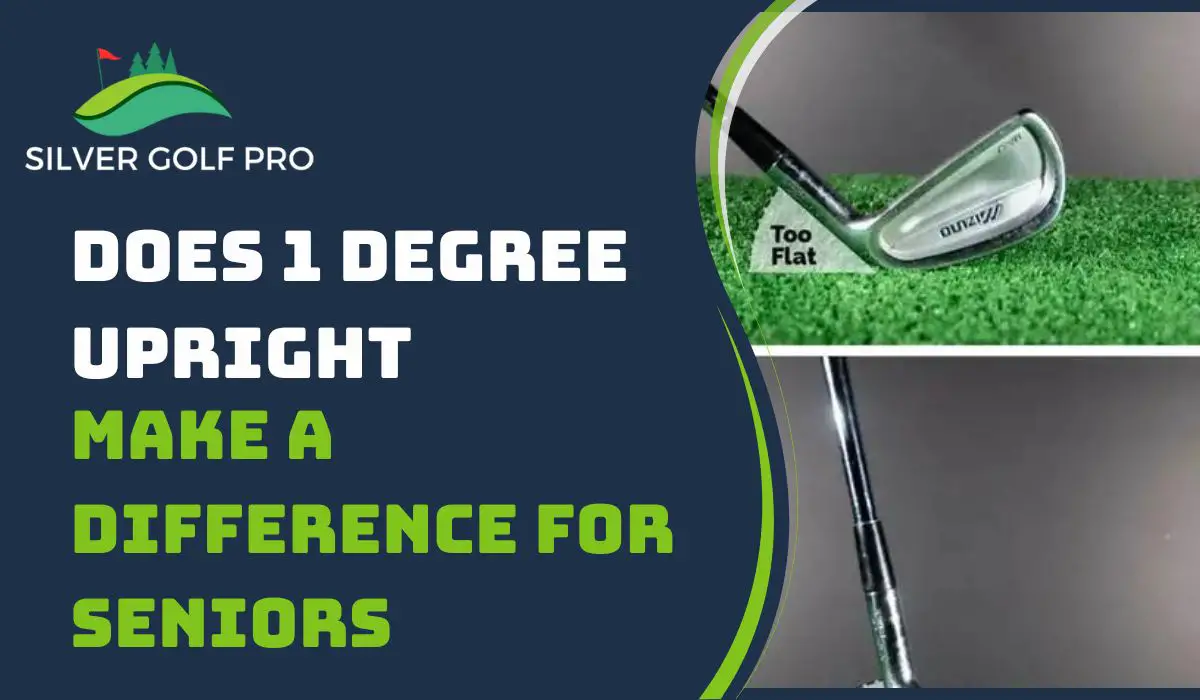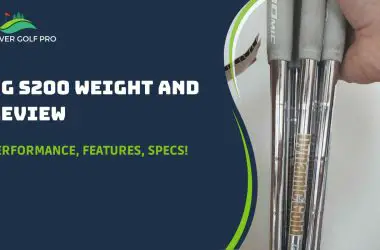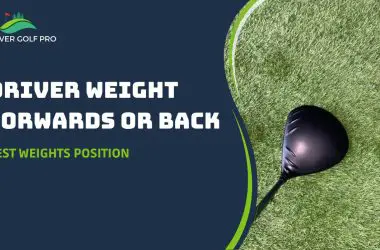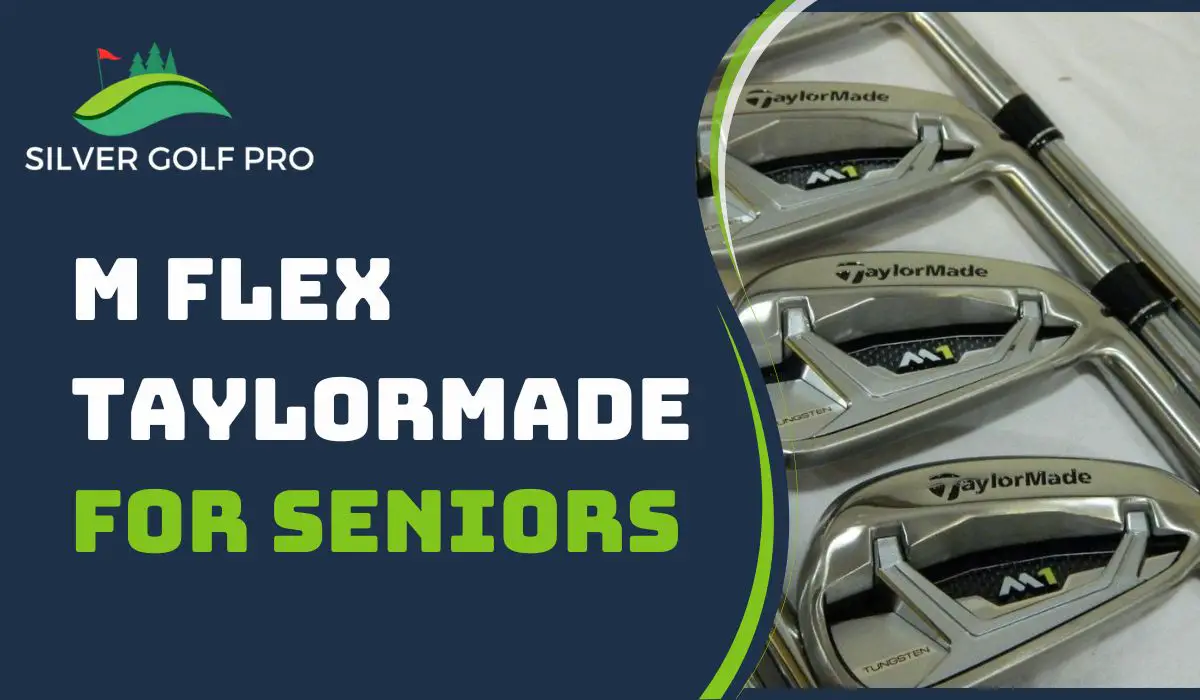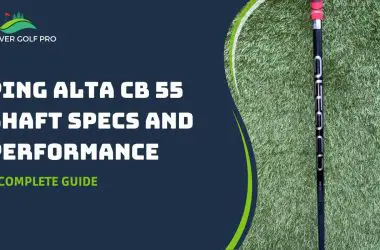Yes, 1 degree upright can make a difference for seniors in golf. As you age, your posture and swing mechanics may change. Adjusting the club’s lie angle to be more upright can help seniors achieve a better impact, improve accuracy, and reduce the likelihood of slices or hooks.
“1 degree upright” refers to the angle at which your golf club’s shaft meets the club head. It means the club head is tilted slightly more upright than the standard angle. For example, if a 7-iron has a normal lie angle of 62 degrees and is adjusted to be 1 degree upright, the new lie angle would be 63 degrees.
This adjustment can significantly impact a golfer’s swing and ball flight. Understanding and optimizing the lie angle is crucial for seniors, as it can help promote better contact with the ball, enhance accuracy, and improve overall performance—or do the opposite.
In the rest of this article, you will learn how adjustments in lie angle affect shot performance, especially for senior golfers, and how you can decide to achieve what you want on the greens.
Skip To Section Here
So Does 1 Degree Upright Really Make A Difference For Seniors?
Now, there are three ways that a 1-degree upright adjustment impacts ball flight and shot dispersion:
- The adjustment encourages a slightly higher ball flight with a reduced tendency for shots to slice (for right-handed golfers).
- This adjustment promotes a more inside-out swing path and helps square the clubface at impact, resulting in straighter shots.
However, the impact on ball flight and shot dispersion can vary based on your swing characteristics and other factors. But as a senior, you’ll most likely be recommended at fittings to get a 1-degree upright adjustment, especially in these areas:
1. Improved Comfort
Seniors often experience body mechanics and posture changes as they age. An upright lie angle can help align the clubhead properly with the ground and the golfer’s swing, promoting a more comfortable and natural setup position.
2. Enhanced Accuracy
The upright lie angle can help seniors achieve a better clubface position at impact. This alignment can lead to improved shot accuracy and a reduced tendency for shots to veer off to the right (for right-handed golfers).
3. Increased Consistency
With an upright lie angle, there’s an increased possibility of finding it easier to consistently strike the ball with the center of the clubface as a senior, resulting in more predictable ball flights.
The caveat
Remember, we all have unique swing characteristics, body types, and flexibility levels, especially when you bring age into the discussion.
So the impact of an upright lie angle may vary from one senior golfer to another. So, individual factors such as your swing, body posture, and ball flight are also relevant to consider before making this adjustment.
Data from these factors can help you pinpoint the appropriate lie angle adjustment that suits your needs.
My colleague Trevor, who got fitted last year for American golf, is 10 HC and plays with Taylormade M3 irons. The professional told him he needed a 1-degree upright lie on his 3, 4, 5, and 6 irons and a 1-degree flat lie on his 9 and PW.
When he told me about it, I immediately (and eventually correctly) assumed that he swung over the top a bit, causing him to come in steep and cast the club. So, in his case, the vertical adjustment made a difference as a response to his swing fault.
Is 1 Degree Upright Recommended For Every Senior?
A one-degree upright adjustment in lie angle is not the solution for every senior golfer. But generally, it’s a promising adjustment because, for seniors, using a club that is 1 degree upright can have potential benefits in terms of accuracy and consistency.
As golfers age, they may experience changes in their posture, flexibility, and swing mechanics. These changes can affect how the clubhead interacts with the ground at impact.
By having a slightly more upright lie angle, seniors can compensate for these changes and ensure that the club head makes proper contact with the ground.
This can lead to more accurate shots and better consistency in ball striking.
But remember, if the lie angle is too upright (or too steep), the toe of the club will be elevated, causing the heel to dig into the ground.
This can lead to the clubface being closed at impact, resulting in shots that tend to veer to the left (for right-handed golfers) and a higher tendency to hit the ground before the ball.
Conversely, if the lie angle is too flat (or too shallow), the heel of the club will be elevated, causing the toe to dig into the ground. This can result in an open clubface at impact, leading to shots that tend to veer to the right (for right-handed golfers) and a higher tendency to hit the top of the ball.
Proper club fitting is highly relevant for seniors’ game improvement.
Your physical characteristics and swing dynamics can change if you’re a senior golfer. So, you need clubs customized to your specific needs and abilities.
A professional club fitting can consider swing speed, body posture, mechanics, and physical limitations.
How Do You Tell If Your Clubs Are Too Upright?
As seniors in golf, who may have specific swing characteristics and physical limitations, it becomes even more essential to ensure that your clubs have the correct lie angle. Signs that indicate clubs might be too upright for seniors include:
1. Consistent miss-hits:
If a senior golfer consistently strikes the ball towards the heel of the clubface, it may indicate that the clubs are too upright. This can result in shots that veer to the left (for right-handed golfers) or a loss of distance.
2. Inconsistent ball flight:
Seniors using clubs with incorrect lie angles may experience inconsistent shot shapes, such as hooks or slices, even when their swing mechanics are relatively consistent. An example would be a senior golfer who typically hits a slight draw but suddenly starts hitting severe hooks or high-flying shots that lack control and accuracy.
3. Impact patterns
Observing the clubface can provide additional clues. If the wear pattern on the clubface appears more concentrated towards the toe, it suggests that the club may be too upright for the golfer.
How do you check the lie angle of your golf clubs?
There are several methods available:
1. You can use professional club fitting services.
They have specialized tools and knowledge to determine the correct lie angle for an individual golfer accurately. Using launch monitors, motion analysis systems, and adjustable clubheads, a fitting club facility can assess your swing dynamics and recommend the appropriate lie angle for your clubs.
2. Visual inspection techniques
A simple visual inspection can provide some indication of the lie angle. Set the club in its address position on a flat surface and observe the alignment of the sole. If the club’s sole appears noticeably off the ground on either the heel or toe side, it may suggest an incorrect lie angle.
3. Lie board or impact tape testing
Lie boards are technological platforms with a flat surface and an embedded piece of impact tape. By hitting shots off the lie board, the impact tape will leave a mark on the club’s sole, indicating the contact point. Analyzing the mark’s position on the clubface can help determine if the lie angle needs adjustment.
4. Dynamic fitting
This method involves hitting shots with a lie angle adjustment device, such as lie angle tape, during a practice session or on a driving range. You can then observe the resulting ball flight and shot patterns, which will give you a hint of adjustment to find the ideal lie angle for your game.
Remember that determining the correct lie angle is not a one-time process. As your swing evolves or your physical characteristics change, you must reassess and potentially adjust the lie angle accordingly to maintain optimal performance.
I love how Ralph Maltby, a professional golfer and founder of GolfWorks, explains it in a YouTube video HERE:
In Summary
If you’re a senior golfer and wondering what a one-degree upright adjustment in the lie angle of your club will do for you, rest assured that it brings more benefits than potential negatives.
- A one-degree upright lie-angle driver is an excellent choice for beginner and senior golfers, especially those struggling with a hook or slice.
- Drivers configured to be one degree upright can help promote a straighter ball flight and improve your accuracy.
- Your body can adjust positively or negatively to the change in lying angle, so get evaluated by an instructor to see if you need further adjustment.
Let me know in the comments what your thoughts are on using irons with a degree of upright adjustment.





